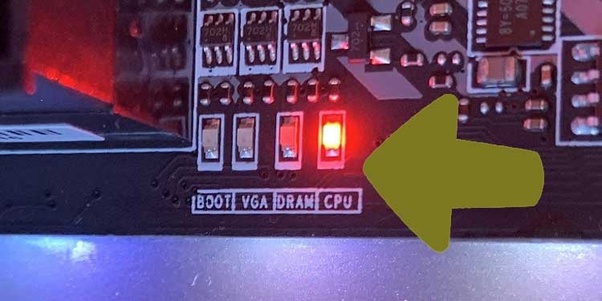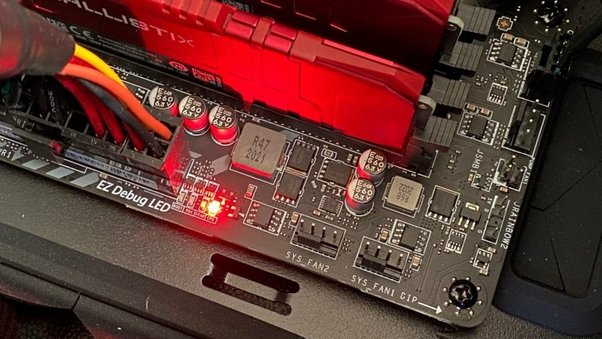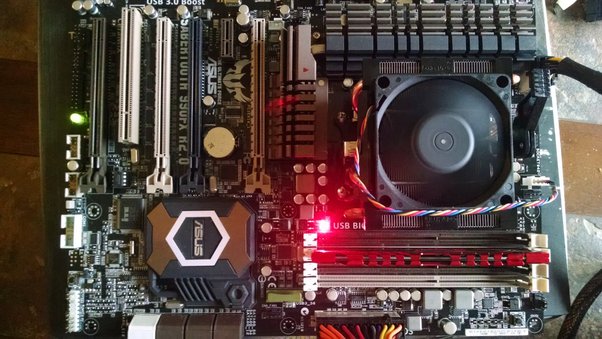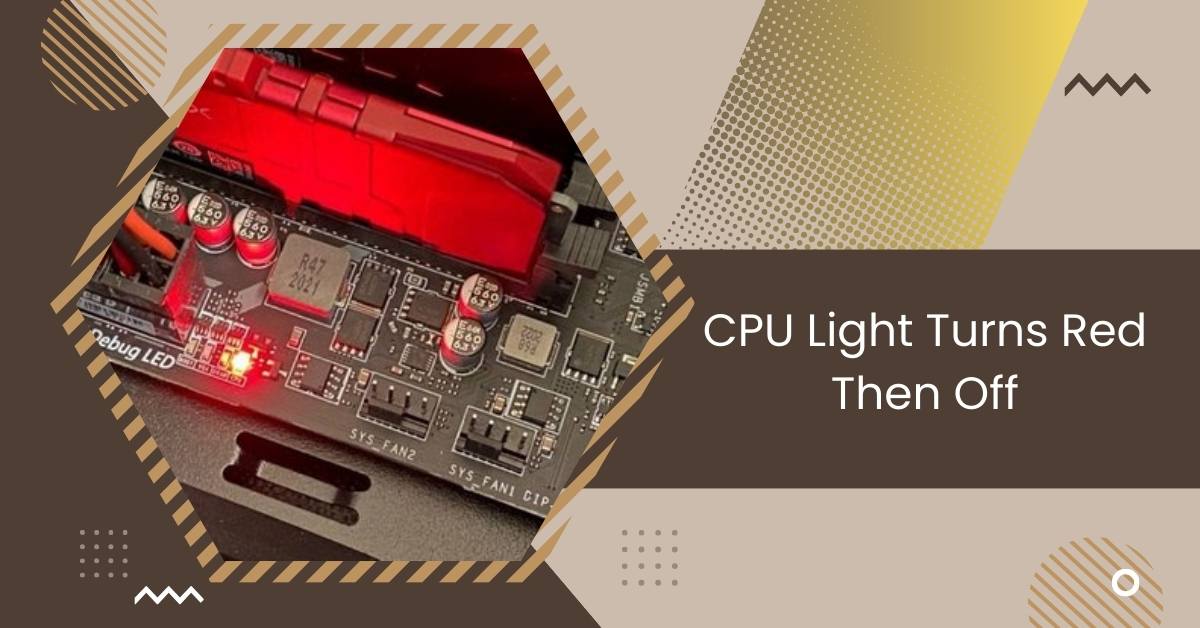When the CPU light turns red and off, it indicates a problem with the processor or system hardware. This may signal overheating, faulty components, or incompatible hardware. Immediate troubleshooting is advised to diagnose and address the underlying cause.
In this article, we’ll explore the reasons behind this occurrence and some troubleshooting steps to help you resolve the issue.
What Does a Red CPU Light Mean?
What does it mean when your CPU light turns red? This is a question that many people may find confusing or worrying.
But when the light on your CPU turns red, it’s like a warning sign. It’s telling you that something might be wrong with your computer.
This could be because it’s getting too hot, there’s a problem with some parts inside, or maybe even the power supply isn’t working right.
It’s important to pay attention to this red light because it could mean a problem needs fixing before it worsens.
How to Troubleshoot a Red CPU Light: A Step-by-Step Guide

When you see a red light on your CPU, it signals that something’s not quite right. To troubleshoot this:
- Start by checking if your computer is getting too hot.
- Ensure all the parts are connected properly and there’s no dust blocking anything. If you need help with what to do, it’s okay to ask for help from someone who knows more about computers.
- Please don’t ignore the red light, as it could mean a problem that needs fixing.
1. Start With the Basics
Let’s begin with the basics. When you notice a red light on your CPU, it’s important to start by checking the simple things.
Ensure all the cables are plugged in correctly, and nothing looks out of place. Sometimes, a loose connection or a simple fix can solve the problem without much hassle.
2. Check CPU Compatibility
Before diving into the complexities, ensure your CPU is compatible with your system. Check the specifications of both your CPU and Motherboard to verify they match.
This simple step can prevent compatibility issues that trigger a red light or other problems.
3. Reset Your BIOS
If you still see that pesky red light after checking compatibility and basic connections, try resetting your BIOS.
The BIOS (Basic Input/Output System) is like the brain of your computer, controlling its most fundamental functions.
Sometimes, resetting it can resolve issues causing the red CPU light. You can usually do this by accessing the BIOS settings during startup and selecting the option to reset to default settings.
Just be sure to follow any prompts carefully to avoid causing further problems.
4. Update Your BIOS
To address persistent issues with the red CPU light, consider updating your BIOS. The BIOS (Basic Input/Output System) is vital for your computer’s functioning, and updates can fix bugs and improve compatibility.
Check your motherboard manufacturer’s website for instructions and the latest BIOS version, ensuring you follow the update process carefully to avoid complications.
5. Reseat the CPU (and Examine the Pins)
If you’re still grappling with the red CPU light, try reseating the CPU. Sometimes, the CPU must be properly seated in its socket, leading to connectivity issues.
Carefully remove the CPU, inspecting it and the socket for any bent pins or damage. Then, reseat it firmly and securely, ensuring proper alignment to resolve the problem potentially.
6. Change CMOS Battery
Consider changing the CMOS battery if you’re encountering persistent issues with the red CPU light.
The CMOS battery powers the BIOS memory, and a failing battery can lead to errors and warnings, including the red CPU light.
It’s a simple, inexpensive fix that may resolve the issue and restore your computer’s functionality.
Read: Why Is My CPU Usage So Low While Gaming: Fix Issues – 2024
Causes of CPU Light Turning Red

1. Overheating: Excessive heat buildup due to inadequate cooling systems or blocked airflow can trigger the CPU light to turn red.
2. Hardware Malfunction: Faulty components such as RAM or graphics cards may cause the CPU light to illuminate.
3. Power Supply Issues: Insufficient power delivery or a failing PSU can turn the CPU light red.
BIOS Errors: Corrupted BIOS settings or outdated firmware may trigger the red CPU light.
4. Software Conflicts: Incompatible or malfunctioning software can cause system errors, including the CPU light turning red.
Motherboard Problems: Faulty connections or damaged motherboard components can lead to CPU light issues.
5. Memory Errors: Faulty RAM modules or improper memory configurations may turn the CPU light red.
6. Graphics Card Problems: Issues with the GPU, such as overheating or driver conflicts, can trigger the red CPU light.
7. Virus or Malware: Malicious software infections can disrupt system operations and trigger warning indicators like the red CPU light.
8. Electrical Surges: Power fluctuations or surges can damage computer components and trigger warning lights, including the CPU light.
Troubleshooting Steps
- Check for Overheating: Monitor CPU temperature and ensure proper cooling system function to prevent overheating.
- Inspect Hardware Connections: Verify all hardware components are securely connected to the Motherboard to prevent connectivity issues.
- Test Power Supply: Use a multimeter to check PSU voltage output and ensure proper power delivery to the system.
- Update BIOS: Install the latest version to address compatibility issues and optimize system performance.
- Scan for Malware: Run antivirus software to detect and remove malicious programs causing system errors.
- Reset BIOS Settings: Reset BIOS to default settings to resolve configuration errors and restore system stability.
- Check for Software Conflicts: Identify and uninstall any incompatible or malfunctioning software causing conflicts.
- Reseat CPU: Remove and re-install the CPU to ensure proper seating and address potential connectivity issues.
- Replace CMOS Battery: Replace the CMOS battery to prevent BIOS memory errors and restore proper system operation.
- Seek Professional Help: If troubleshooting steps fail to resolve the issue, consult a computer technician or contact customer support for further assistance.
Read: Process Lasso Error Setting Process CPU Affinity – Resolve!
Red CPU light On Motherboard With No Display

Encountering a red CPU light on the Motherboard with no display can be concerning. This scenario often indicates a critical hardware or connectivity issue.
Start by checking the basics: ensure all cables, including the monitor cable, are securely connected.
If the problem persists, it may signify deeper hardware problems, such as a faulty CPU, RAM, or Motherboard. Troubleshooting steps may include:
- Reseating components.
- Testing with known working parts.
- Seeking professional assistance to diagnose and resolve the issue.
Red Cpu Light On New Build?
The red CPU light in a new build could indicate overheating, hardware malfunction, or power supply problems. Troubleshoot accordingly to resolve the issue.
Motherboard Cpu Light Turns On Then Off.
If the motherboard CPU light turns on and off, it may suggest overheating, hardware malfunction, or power supply problems. Troubleshoot to identify and resolve the issue promptly.
Pc Won’t Turn On, Motherboard Led Says It’s A CPU Error
Check the CPU and motherboard connections. Ensure the CPU is seated correctly and all power cables are securely connected. Consider resetting the CMOS or testing with another compatible CPU.
Cpu Light Comes On Then Goes Away
If the CPU light briefly illuminates then disappears, it generally indicates a successful POST. Ensure all components are correctly installed and update the BIOS if the issue persists.
Cpu Light Red For A Second Turns Off And Turns On Again Still Red
This could be due to overheating or power supply issues. Check the CPU cooler and thermal paste. Ensure the power supply is adequate and all connections, including the CPU power cable, are secure.
Why Did My Pc Randomly Shut Down And Then The Mobo Gives Me The Red Led Cpu Light?
A random shutdown with a CPU error light could indicate overheating, a faulty power supply, or a problem with the CPU itself. Check cooling systems, review power supply functionality, and inspect the CPU for damage.
CPU Debug Led Blinks Red For A Moment Then Turns Off
This usually indicates a normal POST process. If the system boots successfully afterwards, it’s typically not a concern. Reboot and enter BIOS to check system logs for errors.
Read: Can Cinebench Damage CPU – Ultimate Guide – Click Now!
Shutdowns And Red Cpu Light
Frequent shutdowns with a red CPU light suggest overheating or a failing power supply. Check the cooling system, reapply the thermal paste, and ensure the power supply functions properly.
Red Cpu Light On Motherboard Switched On!
A continuously lit red CPU light may indicate a severe CPU or motherboard connection issue. Re-seat the CPU, ensure all power connections are tight, and test with a known good power supply.
Computer All Of A Sudden Won’t Boot – Red Cpu Debug
Light On
This indicates a potential hardware failure. Check the CPU installation, ensure all cables are securely connected, and try clearing the CMOS. Consider testing with another CPU or motherboard.
Motherboard Cpu Light Flashes For 1 Sec And Turns Off.
A brief flash typically signifies a successful POST. If no boot issues follow this, the system will likely function correctly. If problems persist, update the BIOS and recheck connections.
Cpu Light Red And No Boot After A Week Of Use
A defective CPU, motherboard issue, or inadequate power supply could cause this. Verify all connections, test with a different power supply, and inspect the CPU and socket for damage.
Mobo Cpu Red Light Turns On For 1 Second And Then Nothing Happens
This could suggest a power or motherboard failure. Ensure all power connections are secure, and the PSU is adequate, and consider testing with a different motherboard.
What Does A Red Light In CPU Indicate?
A red light on the CPU typically indicates a hardware failure, power issue, or improper installation. It’s a sign to check the CPU, power supply, and motherboard connections.
How To Troubleshoot Red Light Errors On A Motherboard
Begin by checking the CPU and power connections. Clear the CMOS, update the BIOS, and ensure the power supply functions correctly. Test with alternative components if possible.
How Can You Tell If Your Motherboard Is Dying?
Symptoms include frequent crashes, inability to recognize hardware, BIOS errors, and physical signs like bulging capacitors. If troubleshooting standard components doesn’t resolve issues, the motherboard may need replacing.
Read: CPU Caterr Detected – Solve CPU Catering Detected Error ASAP
CPU Light Turns Red Then Off Gaming
A red CPU light that turns off during gaming typically indicates temporary issues like overheating or power fluctuations. Ensure your cooling system is adequate, and check the power supply for consistent output.
Cpu Light Turns Red Then Off Motherboard
This behaviour might signify a quick self-test before booting. If the PC boots usually afterwards, it’s likely not a problem. If booting fails, check for hardware compatibility and secure connections.
Cpu Red Light On Motherboard No Display
This indicates a possible failure in CPU or GPU connections or malfunction. Re-seat both CPU and GPU, ensure all cables are correctly connected, and check your display output settings in BIOS.
Cpu Led Flashes Then Turns Off
A flashing CPU LED followed by a successful boot indicates a normal Power-On Self-Test (POST). Inspect the CPU installation and motherboard connections if the system doesn’t boot.
Motherboard Light Turns On Then Off
This can be a typical indication of the POST process. If the system powers down immediately after, it may indicate a power supply issue or a short circuit on the motherboard.
Cpu Light On Motherboard Msi
A lit CPU light suggests a CPU or installation problem for MSI motherboards. Check the CPU and socket for bent pins or damage, and ensure the processor is seated correctly.
Is A Red Light In A CPU bad?
A red light on the CPU often points to a critical error, such as improper installation, hardware incompatibility, or failure. It should be investigated by checking the CPU, power supply, and motherboard connections.
Read: Pre Memory CPU Initialization Is Started – Steps By Steps!
Wrapping Things Up
Encountering a red CPU light on the Motherboard with no display can indicate serious hardware or connection issues. Promptly check connections and seek professional help if problems persist for a swift resolution.
Related Questions
1. Why does my CPU light turn red when I start my computer?
The red CPU light may indicate overheating, hardware malfunction, or power supply issues. It’s essential to investigate further to determine the exact cause.
2. How can I prevent my CPU from overheating?
To prevent overheating, ensure proper airflow within the computer case, regularly clean dust buildup, apply thermal paste correctly, and consider upgrading cooling solutions if necessary.
3. What should I do if I suspect a hardware malfunction?
If you suspect a hardware malfunction, try reseating components, checking connections, and testing individual hardware components for faults. Seek professional assistance if needed.
4. Is it safe to continue using my computer if the CPU light turns red?
It’s not recommended to continue using the computer if the CPU light turns red, as it could indicate a serious issue that may cause further damage if ignored. It’s best to shut down the system and investigate the cause.
5. How often should I replace my computer’s power supply unit?
Power supply units can last several years with proper maintenance and usage. However, if you experience frequent issues or notice signs of failure, such as voltage fluctuations or strange noises, consider replacing the PSU.
6. Pc turns on then off briefly with the cpu light blinking once then the dram blinking once then the cpu light blinking one more time help
If your PC turns on briefly with the CPU light blinking once, then the DRAM light blinking once, followed by another CPU light blinking, it suggests potential CPU or RAM issues. Troubleshoot accordingly for resolution.
7. I installed my PC for the first time and the CPU LED on the motherboard is red, but I don’t see any problem. The PC turned on just fine. What could be the problem?
If the CPU LED on your motherboard is red after installing your PC for the first time, but everything seems fine, it may be a false alarm or a minor issue. Monitor for any changes or performance issues.
8. Why is the debug panel CPU red, even if the PC is working fine? I built a PC a few days ago and it turned on just fine, but the CPU LED in the debug pannel is red. Should I be concerned about that?
If the CPU LED on the debug panel is red despite your PC working fine, it could be a false alarm or a minor issue. Monitor your PC’s performance and only be concerned if problems arise.
9. What does the red light mean on my PC?
The red light on your PC can indicate various issues, such as overheating, hardware malfunction, power supply problems, or a system error. Troubleshoot to identify and resolve the underlying cause.
10. What does red light on GPU mean?
A red light on the GPU typically indicates an issue such as overheating, hardware malfunction, or power supply problems. It’s important to troubleshoot to determine the exact cause and address it accordingly.
Read More
- Do CPU Coolers Come With Thermal Paste – A Complete Guide
- CPU Vdd Soc Current Optimization – Optimize CPU Power!
- Is 80c Safe For CPU – Check CPU Temperature For Safety!

Hi everyone, Johns Jack here, your approachable tech aficionado! I’m passionate about CPUs and thrive on keeping up with the newest tech developments. Join me as we delve into the dynamic realm of technology! Visit: Techy Impacts

